
JeanFouquet was a French painter and miniaturist. A master of panel painting and manuscript illumination, and the apparent inventor of the portrait miniature, he is considered one of the most important painters from the period between the late Gothic and early Renaissance. He was the first French artist to travel to Italy and experience first-hand the early Italian Renaissance.
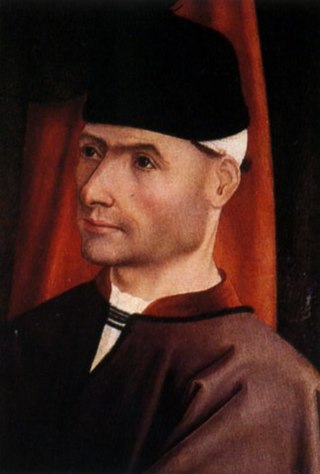
Jean d'Orléans, Count of Dunois, known as the "Bastard of Orléans" or simply Jean de Dunois, was a French military leader during the Hundred Years' War who participated in military campaigns with Joan of Arc. His nickname, the "Bastard of Orléans", was a mark of his high status, since it acknowledged him as a first cousin to the king and acting head of a cadet branch of the royal family during his half-brother's captivity. In 1439 he received the county of Dunois from his half-brother Charles, Duke of Orléans, and later King Charles VII made him count of Longueville.

Domenico di Michelino (1417–1491) was an Italian Renaissance painter who was born and died in Florence. His birth name was Domenico di Francesco. The patronymic "di Michelino" was adopted in honour of his teacher, the cassone painter Michelino di Benedetto, by whom no works have been identified. Giorgio Vasari reports that Domenico was also a pupil of Fra Angelico, whose influence is reflected in many of Domenico's paintings along with that of Filippo Lippi and Pesellino.

Books of hours are Christian prayer books, which were used to pray the canonical hours. The use of a book of hours was especially popular in the Middle Ages, and as a result, they are the most common type of surviving medieval illuminated manuscript. Like every manuscript, each manuscript book of hours is unique in one way or another, but most contain a similar collection of texts, prayers and psalms, often with appropriate decorations, for Christian devotion. Illumination or decoration is minimal in many examples, often restricted to decorated capital letters at the start of psalms and other prayers, but books made for wealthy patrons may be extremely lavish, with full-page miniatures. These illustrations would combine picturesque scenes of country life with sacred images.

The Très Riches Heures du Duc de Berry, or Très Riches Heures, is an illuminated manuscript that was created between c. 1412 and 1416. It is a book of hours, which is a Christian devotional book and a collection of prayers said at canonical hours. The manuscript was created for John, Duke of Berry, the brother of King Charles V of France, by Limbourg brothers Paul, Johan and Herman. The book is now MS 65 in the Musée Condé, Chantilly, France.

The Fécamp Bible is an illuminated Latin Bible. It was produced in Paris during the third quarter of the 13th century, and had previously belonged in the collection of Henry Yates Thompson.

Louis-Simon Boizot (1743–1809) was a French sculptor whose models for biscuit figures for Sèvres porcelain are better-known than his large-scale sculptures.

The Bedford Master was a manuscript illuminator active in Paris during the fifteenth century. He is named for the work he did on two books illustrated for John of Lancaster, 1st Duke of Bedford between 1415 and 1435. One is the Bedford Hours, a book of hours in the British Library ; the other, the Salisbury Breviary, is in the Bibliothèque nationale de France. Another manuscript is in the Royal Collection. The Bedford Master is known to have been the head of a workshop; his chief assistant is known as the Chief Associate of the Bedford Master.

Jean Poyer, was a French painter and manuscript illuminator of the late 15th century. As a multitalented artist - illuminator, painter, draftsman, and festival designer active from 1483 until his death - he was a painter of Renaissance France, working for the courts of three successive French kings: Louis XI, Charles VIII, and Louis XII.
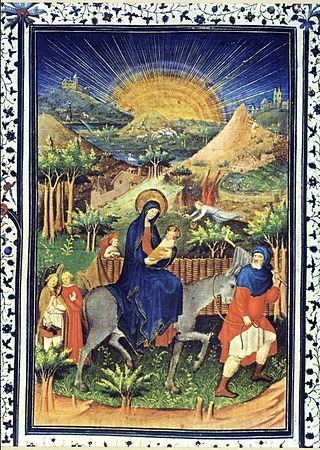
The Hours of Jean de Boucicaut is believed to have been created between 1405 and 1408. It contains the Paris Liturgy of the Hours. While characterized by typical Parisian styles of illumination, some illustrations in the manuscript are quite innovative. This manuscript contains 44 miniatures by the Boucicaut Master, possibly within the assistance of students, and is now in the Musée Jacquemart-André, Paris, ms. 2. The Boucicaut Master experimented with perfecting aerial perspective and with his works established the precedent of historically portraying biblical scenes. Jean de Boucicaut, who was a Marshal of France, commissioned the book as a tool of daily devotion. The illuminated pages correspond to events in Marshal Jean de Boucicaut's life as well as incorporating biblical figures with whom he identifies.
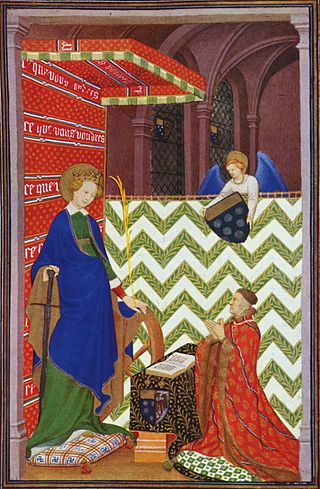
The Boucicaut Master or Master of the Hours for Marshal Boucicaut was an anonymous French or Flemish miniaturist and illuminator active between 1400 and 1430 in Paris. He worked in the International Gothic style.
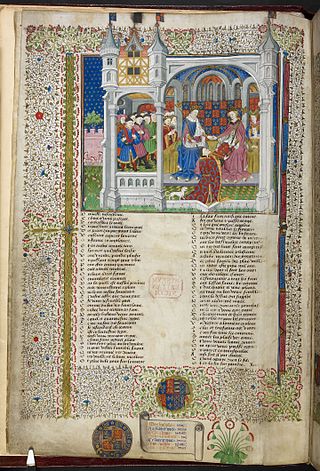
The Talbot Shrewsbury Book is a very large richly-illuminated manuscript made in Rouen (Normandy) in 1444/5. It was presented by John Talbot, 1st Earl of Shrewsbury to the French princess, Margaret of Anjou, in honour of her betrothal to King Henry VI. It contains a unique collection of fifteen texts in French, including chansons de geste, chivalric romances, treatises on warfare and chivalry, and finally the Statutes of the Order of the Garter. The work is an excellent example of book production in Rouen in the mid-fifteenth century and provides a rare insight into the political views of the English military leader and close confidant of the crown, John Talbot.
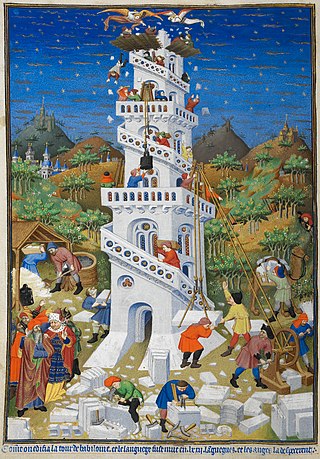
The Bedford Hours is a French late medieval book of hours. It dates to the early fifteenth century (c. 1410–30); some of its miniatures, including the portraits of the Duke and Duchess of Bedford, have been attributed to the Bedford Master and his workshop in Paris. The Duke and Duchess of Bedford gave the book to their nephew Henry VI in 1430. It is in the British Library, catalogued as Add MS 18850.

The Book of Hours of Simon de Varie is a French illuminated manuscript book of hours commissioned by the court official Simon de Varie, with miniatures attributed to at least four artists; hand A who may have been a workshop member of the Bedford Master, the anonymous illustrators known as the Master of Jean Rolin II, the Dunois Master and the French miniaturist Jean Fouquet. It was completed in 1455 and consists of 49 large miniatures and dozens of decorative vignettes and painted initials, which total over 80 decorations. Fouquet is known to have contributed six full leaf illuminations, including a masterwork Donor and Virgin diptych. A number of saints appear - Saint Simon is placed as usual alongside Saint Jude ; other pages feature saints Bernard of Menthon, James the Greater and Guillaume de Bourges.

The Pseudo-Jacquemart was an anonymous master illuminator active in Paris and Bourges between 1380 and 1415. He owed his name to his close collaboration with painter Jacquemart de Hesdin.
Laurence des Cars is a French museum curator and art historian. Since September 2021, she has served as director of the Louvre Museum, having previously headed the Musée d'Orsay and Musée de l'Orangerie.

The Master of the Burgundian Prelates was an anonymous master illuminator active in Burgundy between 1470 and 1490. He owes his name to several works commissioned from him by Burgundian bishops and abbots.

The Egerton Hours is a book of hours of the use of Paris, illuminated in France during the 15th century. The manuscript belonged to the Valois-Anjou family and probably to René of Anjou. It is currently held in the British Library as MS Egerton 1070.
The Master of Cardinal de Bourbon was an anonymous master illuminator active in France between 1470 and 1500. His name was inspired by the manuscript evoking the life and miracles of Saint Louis, illuminated for the cardinal and archbishop of Lyon, Charles II de Bourbon. Little is known about his career, which is largely based on conjecture. Born in Flanders, he trained in the orbit of the Master of Margaret of York's group in the Bruges region. He may have passed through Rouen in the 1470s, before settling in Paris in the 1480s, where he illuminated a large number of manuscripts for relatives of King Louis XI. It has been suggested that he was identified with Guérard Louf, a painter and sculptor from Utrecht who settled in Rouen, but this identification has since been called into question.


















